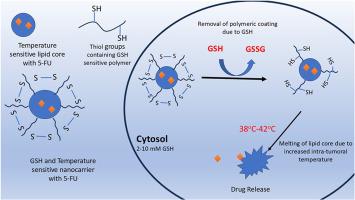Thiomer-coated solid lipid nanoparticles for the glutathione and temperature-responsive drug delivery against breast cancer
IF 4.9
3区 医学
Q1 PHARMACOLOGY & PHARMACY
Journal of Drug Delivery Science and Technology
Pub Date : 2025-09-29
DOI:10.1016/j.jddst.2025.107579
引用次数: 0
Abstract
Breast cancer is the most prevalent type of cancer among women. Despite extensive efforts, existing cancer therapies often yield suboptimal outcomes due to their inherent off-target toxicity and the emergence of multidrug resistance in tumor cells. Thus, there exists a pressing need to explore innovative nanotechnology-based drug delivery systems to address these challenges. The present study aimed to develop temperature and glutathione (GSH)-responsive nanocarriers to selectively deliver 5-Fluorouracil (5-FU) to the breast cancer tumor. For this purpose, 5-FU loaded temperature-sensitive solid lipid nanoparticles (SLNs) were formulated using Lauric Acid and Oleic acid-based binary mixture with a melting range of 39–42 °C. A glutathione-responsive polymeric coating of folate grafted thiolated chitosan (FTCS) was coated onto developed lipid cores and evaluated in terms of physicochemical characterization, in-vitro drug release in normal physiological conditions as well as in the presence of glutathione and at a temperature of 39 °C. Evaluation of anticancer activities was carried out in vitro using MDA-MB-123 cancer cell lines and in-vivo in a chemical-induced breast cancer rat model. FTCS-SLN-5-FU exhibited an average size of 274.6 ± 2.62 nm and zeta potential of +18.74 ± 0.22 mV as compared to non-coated 5-FU loaded nanoformulation (SLN-5-FU) with average particle size of 184 ± 20.51 nm and zeta potential of 19 ± 0.27 mV, thus confirming the successful coating of the cationic FTCS. The SEM images of formulations showed well-defined nano-sized particles. In-vitro drug release studies have confirmed the glutathione and temperature-sensitive behavior of FTCS-SLN-5-FU, indicating 80.32 ± 8.5 % of 5-FU release at pH 5.8, 39 °C temperature in the presence of 20 mM glutathione compared to 10.21 % ± 1.89 % of drug release at pH 7.4 during the first 24 h. Invitro anticancer activity revealed a significantly reduced viability in the case of FTCS-SLN-5-FU compared to SLN-5-FU. Similarly, In-vivo anticancer activity in breast cancer-induced rat models indicated significantly reduced tumor weight compared to SLN-5-FU and 5-FU. The results provided proof of the concept that utilizing temperature and GSH-sensitive nanocarriers can be a suitable strategy to enhance the intratumoral delivery and thus anticancer activity of the drugs.

用于谷胱甘肽和温度响应性乳腺癌药物递送的硫高分子包被固体脂质纳米颗粒
乳腺癌是女性中最常见的癌症类型。尽管付出了巨大的努力,但现有的癌症治疗方法由于其固有的脱靶毒性和肿瘤细胞中多药耐药性的出现,往往产生不理想的结果。因此,迫切需要探索基于创新纳米技术的给药系统来应对这些挑战。本研究旨在开发温度和谷胱甘肽(GSH)响应的纳米载体,选择性地将5-氟尿嘧啶(5-FU)递送到乳腺癌肿瘤。为此,采用月桂酸和油酸二元混合物制备了负载5-FU的温度敏感固体脂质纳米颗粒(SLNs),熔点范围为39-42℃。将叶酸接枝巯基壳聚糖(FTCS)的谷胱甘肽响应聚合物包被包被在发育的脂质核上,并在正常生理条件下、谷胱甘肽存在下和温度39℃下对其进行了理化表征和体外药物释放评价。在体外用MDA-MB-123癌细胞系和体内化学诱导乳腺癌大鼠模型对其抗癌活性进行了评价。SLN-5-FU平均粒径为274.6±2.62 nm, zeta电位为+18.74±0.22 mV,而未包覆的SLN-5-FU平均粒径为184±20.51 nm, zeta电位为19±0.27 mV,证实了阳离子型FTCS包覆成功。配方的SEM图像显示出明确的纳米级颗粒。体外药物释放研究证实了FTCS-SLN-5-FU的谷胱甘肽和温度敏感性行为,表明在pH 5.8, 39℃温度下,20 mM谷胱甘肽存在下,在前24小时内,80.32%±8.5%的5-FU释放,而在pH 7.4下,药物释放率为10.21%±1.89%。体外抗癌活性显示,FTCS-SLN-5-FU与SLN-5-FU相比,活性显著降低。同样,乳腺癌诱导大鼠模型的体内抗癌活性表明,与SLN-5-FU和5-FU相比,肿瘤重量显著降低。这些结果证明了利用温度和谷胱甘肽敏感的纳米载体是一种合适的策略,可以增强肿瘤内的递送,从而提高药物的抗癌活性。
本文章由计算机程序翻译,如有差异,请以英文原文为准。
求助全文
约1分钟内获得全文
求助全文
来源期刊
CiteScore
8.00
自引率
8.00%
发文量
879
审稿时长
94 days
期刊介绍:
The Journal of Drug Delivery Science and Technology is an international journal devoted to drug delivery and pharmaceutical technology. The journal covers all innovative aspects of all pharmaceutical dosage forms and the most advanced research on controlled release, bioavailability and drug absorption, nanomedicines, gene delivery, tissue engineering, etc. Hot topics, related to manufacturing processes and quality control, are also welcomed.

 求助内容:
求助内容: 应助结果提醒方式:
应助结果提醒方式:


